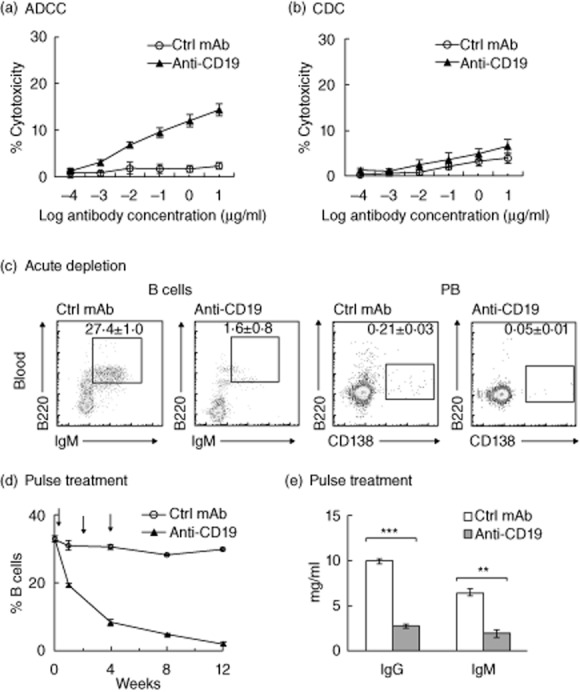Fig. 2.

Anti-CD19 monoclonal antibody (mAb)-mediated effector function and B cell depletion in peripheral blood. (a) Antibody-dependent cell-mediated cytotoxicity (ADCC). The lactate dehydrogenase (LDH) release assay was performed using A20 cells (murine B cell lymphoma) as target cells, and J774·2 cell lines (murine monocytic cell line) or purified mouse natural killer (NK) cells as effector cells (n = 4). Effector cell/target cell ratio: 2·5:1. (b) Complement-dependent cytotoxicity (CDC). A20 cells were incubated with anti-CD19 mAb or isotype control at various concentrations in the presence of mouse serum (source of complement) (n = 3). (c) Acute depletion of peripheral blood B cells and plasmablasts (PB) by anti-CD19 mAb (250 μg) administered intravenously (i.v.) thrice every other day. Experiments were performed on day 8. Total lymphocytes were used for gating based on immunoglobulin (Ig)M and B220 for B cells, and CD138 and B220 for PB. Mean ± standard error of the mean (s.e.m.) percentages are indicated in the scatterplots. Comparing control mAb versus anti-CD19, P < 0·00001 for B cells, P < 0·009 for PB (n = 4–6). (d) Time–course of B cell depletion in the blood using the pulse treatment paradigm. Arrows: i.v. injections with control mAb or anti-CD19 mAb (250 μg) thrice every other week (n = 4). Blood samples were obtained by serial retro-orbital bleeding. The first treatment was given the day after the baseline sample was collected. (e) Reduction in serum IgG and IgM levels by pulse treatment with anti-CD19 mAb. Data from 8 weeks and 12 weeks post-treatment initiation were pooled together and shown as mean ± s.e.m. [**P < 0·0014 for IgM and ***P < 0·00001 for IgG (n = 9 each)].
